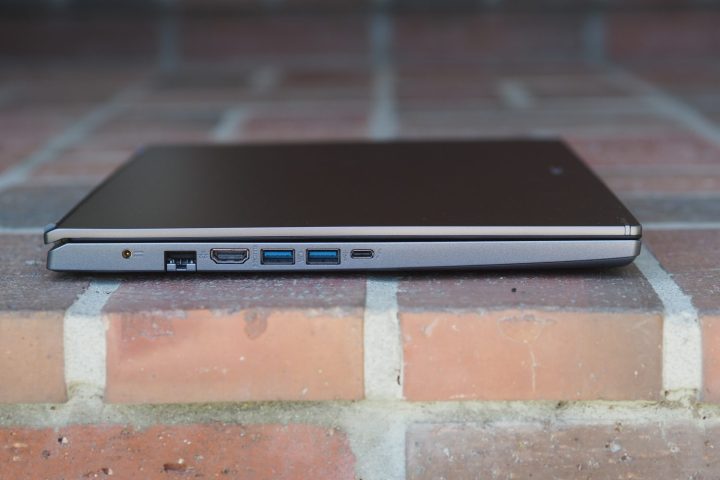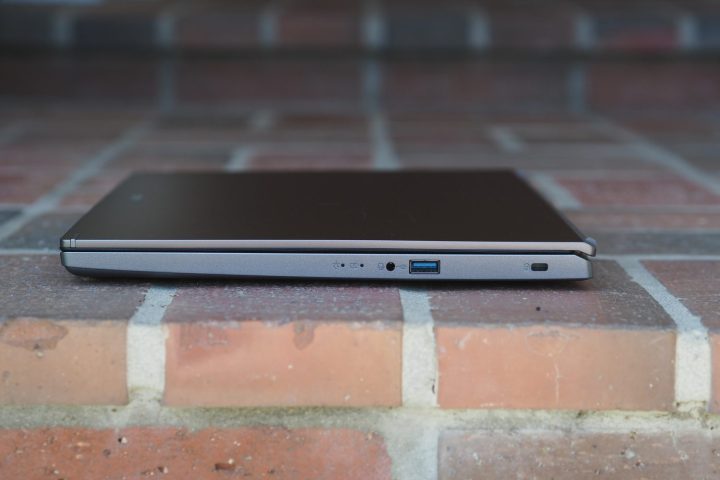
Acer Aspire 5 (2022)
MSRP $700.00
“The Acer Aspire 5 (2022) is an increasingly rare budget laptop with the latest Intel 12th-gen chips.”
Pros
- Solid productivity performance
- Excellent port selection
- Impressive expandability
- Touchpad is comfortable
- Great value
Cons
- Below-average battery life
- Keyboard feels loose and imprecise
- No Windows Hello support
The 2019 Acer Aspire 5 was an excellent $400 budget laptop that made its way to our best laptops list. Then a funny thing happened: The following two versions took significant steps backward, falling off our lists and failing to garner recommendations. Now, Acer has introduced its 2022 Acer Aspire 5 that updates to Intel’s 12th-gen CPUs while raising the entry-level price to $650.
I reviewed the second least expensive model of the Acer Aspire 5, a $700 (currently on sale for $600) configuration with a Core i5-1235U CPU and a 15.6-inch Full HD (1,290 x 1,080) IPS display. The price has gone up, or rather, there’s no longer a configuration less than $500, meaning that the laptop doesn’t have extreme value in its favor. Fortunately, it improves in several key areas and makes for a more compelling budget choice.
Design
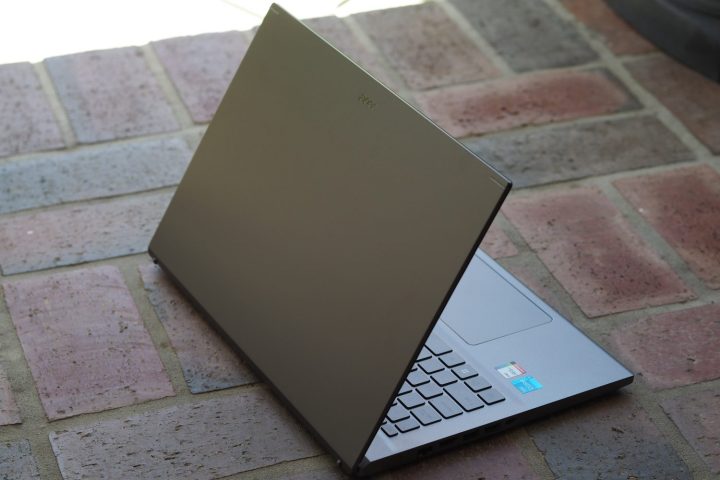
The 2022 Aspire 5 saw only a few design changes from the previous version, including a sleeker keyboard deck and a switch to a magnesium-aluminum alloy in the lid. Otherwise, it’s the same dark gray chassis with simple lines and angles and zero bling outside of a couple of Acer logos. The plastic display bezels are relatively large, with an 81% screen-to-body ratio that feels a bit old school.
Budget laptops tend to be plain in their designs, though, and the Aspire 5 is no different. Note that Acer will be offering models with blue and gold lids that add some panache.
The laptop is constructed of plastic outside of the lid, and its build quality is acceptable for a budget laptop. There’s some bending in the lid and some flexing in the keyboard deck, but it’s not egregious. The Lenovo Flex 5 14 and Acer Swift 3 have slightly more rigid builds, but the Aspire 5 is typical for a laptop that’s well under $1,000. The hinge still props the laptop up at a slight angle to make typing more comfortable and increase airflow, and it’s still a little loose with a lid that wobbles during heavy typing.
Thanks to the large bezels and 16:9 display aspect ratio, the Aspire 5 is wider than many 15-inch laptops. It’s not as deep as some that sport 16:10 aspect ratios, and it’s reasonably thin at 0.70 inches and light at 3.88 pounds.
Ports and expandability
The Aspire 5 stands out in its expandability. The insides are user-accessible, and the RAM can be upgraded while there’s a second storage slot for another SSD. Most modern laptops aren’t so easily upgradable, making the Aspire 5 more future-proof than most.
Connectivity is another strength. This year’s model includes a USB-C port with Thunderbolt 4 support, something you don’t always see in budget laptops. There are also three USB-A 3.2 Gen 2 ports, a full-size HDMI 2.1 port, an Ethernet port, and a 3.5mm audio jack. Unfortunately, there’s no SD card reader. Wireless connectivity includes Wi-Fi 6E and Bluetooth 5.2.
Performance
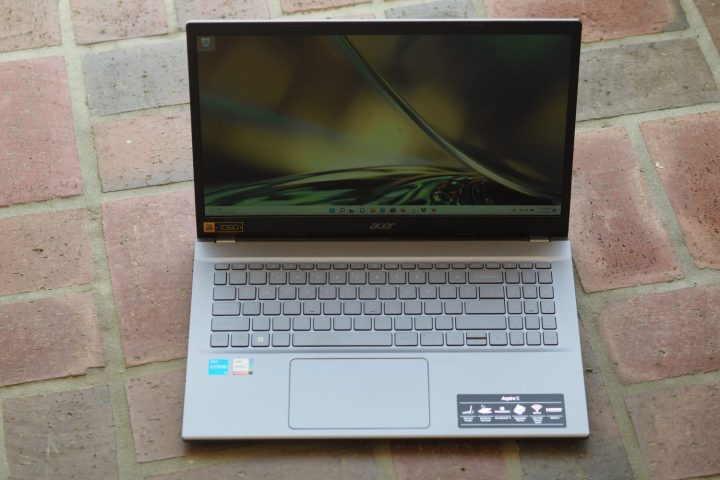
My first observation is that the 2022 Aspire 5 is significantly faster than last year’s model. That’s no surprise given the low-power Core i3 in the previous model, and there’s certainly $200 worth of performance improvement. Where the 2021 Acer Aspire 5 was too slow even for $480 or so, the 2022 version is fast enough to compete with laptops that cost considerably more.
Either way, these are laptops meant for simple tasks and productivity in work — not more intense workloads like AAA games or 4K video editing.
To that end, my review unit was equipped with the Intel Core i5-1235U, a 15-watt 10-core (two Performance and eight Efficient), 12-thread CPU that slots in the middle of Intel’s 12th-gen lineup for thin-and-light laptops. Above it is the 28-watt 12-core (four Performance and eight Efficient), 16-thread P-series, and below it is the nine-watt U-series with the same core and thread count. This is the first Core i5-1235U we’ve tested, but we have the Core i7-1255U with a max Turbo frequency of 4.7GHz that we can compare to the Core i5 with a max of 4.4GHz.
Because this is a new CPU, I created a comparison group of other modern processors rather than focusing on similar budget laptops. We also haven’t reviewed many 15-inch budget laptops in a while, so we don’t have many recent models to compare to in the same price range as the Aspire 5. I used Acer’s thermal performance tuning utility and found little difference between the laptop’s balanced and performance modes, but I reported both results in the table below.
For the money, the all-around performance was more than acceptable.
As a case in point, consider the $1,050 Dell Inspiron 14 2-in-1 running the higher clocked Core i7-1255U. The Aspire 5 was significantly faster in all our benchmarks except PCMark 10 Complete, where it was quicker but not by such a significant margin. That’s likely down to the Aspire 5’s larger chassis and better thermals — the Dell did demonstrate more throttling than the Acer. The Aspire 5 was also much faster than the 35-watt four-core/eight-thread Core i7-11370H in the $1,000 Acer Swift 3 16.
On the other hand, the Aspire 5 was notably slower than the Lenovo Yoga 9i 14 Gen 7 with the Core i7-1260P, but that’s no surprise. It also fell behind the Asus ZenBook S 13 OLED with the eight-core, 16-thread AMD Ryzen 7 6800U running at 28 watts, especially in multi-core tests. Again, that’s to be expected and not a knock against the Acer.
Overall, the Aspire 5 provided fast performance for demanding productivity workflows, and it fell behind in CPU-intensive creative tasks. For the money, the all-around performance was more than acceptable for a laptop of its type.
| Geekbench (single / multi) |
Handbrake (seconds) |
Cinebench R23 (single / multi) |
PCMark 10 Complete |
|
| Acer Aspire 5 2022 (Core i5-1235U) |
Bal: 1,565 / 7,352 Perf: 1,564 / 6,908 |
Bal: 134 Perf: 129 |
Bal: 1,668 / 7,671 Perf: 1,659 / 7,906 |
5,175 |
| Acer Aspire 5 2021 (Core i3-1115G4) |
Bal: 1,215 / 2,544 Perf: 1,300 / 2,566 |
Bal: 300 Perf: 297 |
Bal: 1,274 / 3,128 Perf: N/A |
3,752 |
| Dell Inspiron 14 2-in-1 (Core i7-1255U) |
Bal: 1,703 / 6,520 Perf: 1,685 / 6,791 |
Bal: 153 Perf: 141 |
Bal: 1,729 / 6,847 Perf: 1,773 / 7,009 |
5,138 |
| Lenovo Yoga 9i 14 Gen 7 (Core i7-1260P) |
Bal: 1,717 / 9,231 Perf: 1,712 / 10,241 |
Bal: 130 Perf: 101 |
Bal: 1,626 / 7,210 Perf: 1,723 / 8,979 |
5,760 |
| Acer Swift 3 16 (Core i7-11370H) |
Bal: 1,619 / 6,119 Perf: N/A |
Bal: 159 Perf: 153 |
Bal: 1,568 / 5,806 Perf: 1,566 / 6,053 |
5,491 |
| Asus ZenBook 14X OLED (Core i7-1165G7) |
Bal: 1,536 / 5,780 Perf: 1,527 / 5,776 |
Bal: 175 Perf: 162 |
Bal: 1,479 / 5,717 Perf: 1,502 / 6,252 |
5,366 |
| Asus ZenBook S 13 OLED (Ryzen 7 6800U) |
Bal: 1,417 / 6,854 Perf: 1,404 / 7,223 |
Bal: 112 Perf: 111 |
Bal: 1,402 / 8,682 Perf: 1,409 / 8,860 |
5,647 |
Gaming performance was a different story. The Aspire 5 scored just 1,285 in the 3DMark Time Spy test, which is well below the Intel Iris Xe average. It also managed just 11 frames per second (fps) in Fortnite and 1,080p and epic graphics.
Don’t count on the Aspire 5 for anything but very casual gaming. Although it’s not available yet on Acer’s website, there will be a version with an Nvidia GeForce RTX 2050 that should provide much better gaming performance, but even that uses a last-gen budget graphics card.
| 3DMark Time Spy |
Fortnite (1080p/1200p Epic) |
|
| Acer Aspire 5 2022 (Intel Iris Xe) |
Bal: 1,285 Perf: 1,289 |
Bal: 11 fps Perf: 11 fps |
| Acer Aspire 5 2021 (Intel UHD graphics) |
Bal: 652 Perf: 655 |
Bal: 5 fps Perf: N/A |
| Dell Inspiron 14 2-in-1 (Intel Iris Xe) |
Bal: 1,492 Perf: 1,502 |
Bal: 12 fps Perf: 12 fps |
| Lenovo Yoga 9i 14 Gen 7 (Intel Iris Xe) |
Bal: 1,658 Perf: 1,979 |
Bal: 12 fps Perf: N/A |
| Acer Swift 3 16 (Intel Iris Xe) |
Bal: 1,911 Perf: N/A |
Bal: 24 fps Perf: N/A |
| Asus ZenBook 14X OLED (GeForce MX450) |
Bal: 1,756 Perf: 1,765 |
Bal: 18 Perf: N/A |
| Asus ZenBook S 13 OLED (Radeon graphics) |
Bal: 2,110 Perf: 2,213 |
Bal: 19 fps Perf: 19 fps |
Display and audio
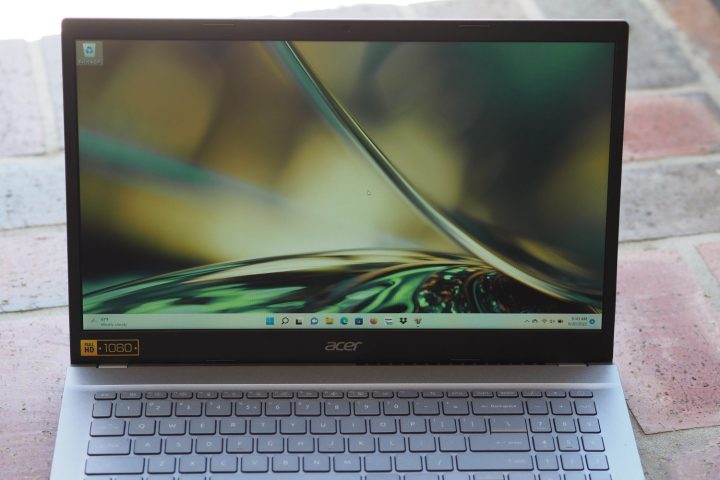
The biggest reason the last year’s Aspire 5 received a low score was its display, which was the worst we’ve seen in a laptop in years. It was atrocious, with narrow and inaccurate colors, low brightness, and a horribly low contrast ratio. Whether the Aspire 5 2022 version would make its way back onto our recommended list had a lot to do with the quality of its display.
To begin with, Acer retained the old-school 16:9 aspect ratio when most contemporary laptops have migrated to taller, more productivity-friendly 16:10 or 3:2 panels. That’s forgivable in a budget laptop, however. More important would be the colors, contrast, and brightness, and out of the box, I was immediately struck by a display that at least looked decent. The colors weren’t all that dynamic, but they weren’t oversaturated, either. While blacks had a slight hint of gray, the contrast didn’t seem bad for a laptop well under $1,000. I was hopeful.
According to my colorimeter, Acer dropped the display from the last version and sourced a much better panel. Brightness was slightly less than our 300-nit baseline at 282 nits, but that’s bright enough for most indoor settings. Colors weren’t very wide at just 65% of sRGB and 48% of AdobeRGB, but accuracy wasn’t terrible at a DeltaE of 2.79 (anything less than 2.0 can be used more reliably for visual creative work). These aren’t great, mind you, but they are acceptable scores for a budget laptop. The contrast was higher than the previous model at 740:1, below our preferred 1,000:1 but again, not terrible for a budget machine.
The Aspire 5’s display is fine for productivity work but doesn’t offer the colors needed for creative tasks. It’s equal to the displays in the more expensive Dell Inspiron 14 2-in-1 and the $1,400 Samsung Galaxy Book Odyssey but below the other IPS displays in our comparison group. But for a budget laptop, the display is more than adequate.
| Brightness (nits) |
Contrast | sRGB gamut | AdobeRGB gamut | Accuracy DeltaE (lower is better) |
|
| Acer Aspire 5 2022 (IPS) |
282 | 740:1 | 65% | 48% | 2.79 |
| Acer Aspire 5 2021 (IPS) |
211 | 60:1 | 53% | 40% | 10.7 |
| Acer Swift 3 16 (IPS) |
334 | 1,530:1 | 100% | 77% | 1.11 |
| Samsung Galaxy Book Odyssey (IPS) |
350 | 800:1 | 65% | 48% | 2.37 |
| Dell Inspiron 14 2-in-1 (IPS) |
288 | 1,330:1 | 63% | 48% | 3.35 |
| Lenovo IdeaPad Slim 7 16 Pro (IPS) |
420 | 1,310:1 | 100% | 80% | 1.59 |
Two downward-firing speakers on the front bottom of the chassis provide audio that doesn’t get very loud and, even so, has some distortion when turned all the way up. Highs are lacking, with most emphasis on the mids, and there’s zero bass. You’ll want to pull out a pair of headphones for anything other than simple system sounds.
Keyboard, touchpad, and webcam
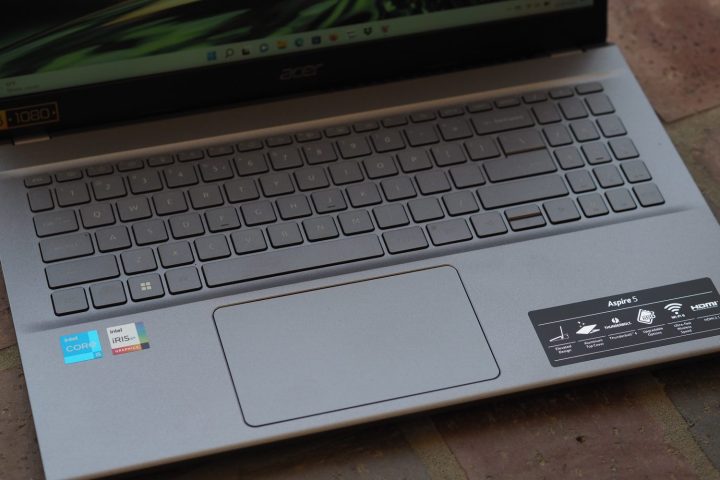
The Aspire 5’s keyboard has nicely sized keycaps and plenty of key spacing, even given the numeric keypad. Unfortunately, its switches are loose, with an abrupt bottoming action that’s uncomfortable over long typing sessions. It’s well behind the best laptop keyboards out there.
The touchpad is much better, being large enough for comfortable use and offering a smooth surface for Windows 11 multitouch gestures, which are well-supported thanks to Microsoft Precision touchpad drivers. The buttons have a soft, quiet click that’s confident and pleasant to use.
Windows 11 Hello passwordless login is provided by an optional fingerprint reader embedded in the upper-left corner of the touchpad. However, my review unit wasn’t equipped with that feature, so I could not test it. Not having any form of passwordless security is a shame, even on a laptop of this price.
The webcam is 720p and offers Acer’s noise reduction technology. It provided decent image quality even in low light, but it can’t keep up with the increasingly common 1080p webcams we’re seeing in premium laptops.
Battery life
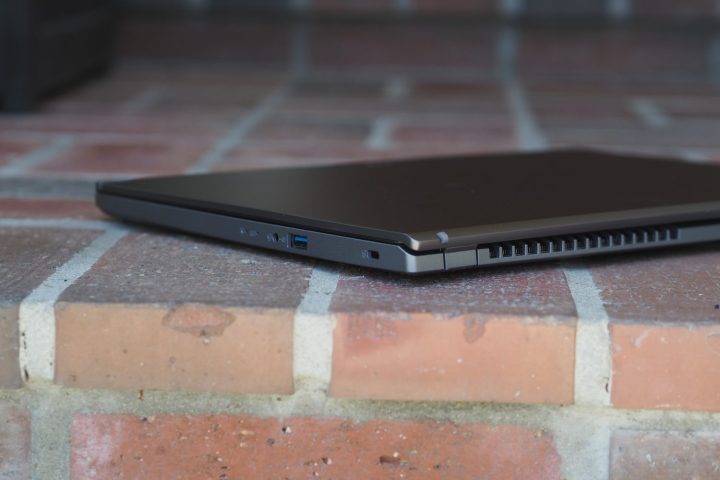
The Aspire 5’s battery is only 50 watt-hours, which isn’t a lot for a 15-inch laptop. The display is just Full HD, though, and the Core i5-1235U is intended to be a more efficient CPU, so I expected reasonable battery life.
What I saw was slightly less than that. In our web browsing test that cycles through popular and complex websites, the Aspire 5 lasted about 6.5 hours. That’s less than average and the lowest among our comparison group. It managed 10.75 hours in our video test that loops a local Full HD Avengers trailer, which is also less than average. And to complete the theme, the Aspire 5 managed 8.25 hours in the PCMark 10 Applications test that’s the best indication of productivity battery life. That’s competitive without our comparison group but again below average overall.
The Aspire 5 is unlikely to make it through a full day’s work unless your workflow is exceptionally light. You’ll want to carry the proprietary charger along with you, which fortunately is reasonably small.
| Web browsing | Video | PCMark 10 Applications |
|
| Acer Aspire 5 2022 (Core i5-1235U) |
6 hours, 25 minutes | 10 hours, 41 minutes | 8 hours, 18 minutes |
| Acer Aspire 5 2021 (Core i3-1115G4) |
6 hours, 55 minutes | 9 hours, 29 minutes | 7 hours, 53 minutes |
| Dell Inspiron 14 2-in-1 (Core i7-1255U) |
6 hours, 42 minutes | 10 hours, 6 minutes | 8 hours, 43 minutes |
| Acer Swift 3 16 (Core i7-11370H) |
8 hours, 42 minutes | 12 hours, 56 minutes | 9 hours, 32 minutes |
| Lenovo Yoga 9i 14 Gen 7 (Core i7-1260P) |
9 hours, 10 minutes | 12 hours, 45 minutes | 8 hours, 32 minutes |
| Asus Zenbook S 13 OLED (Ryzen 7 6800U) |
8 hours, 4 minutes | 13 hours, 13 minutes | N/A |
Price and configurations
The current Acer Aspire 5 lineup carries the model number A515-57, and within that range, the entry-level configuration is $660 for a Core i5-1235U, 8GB of LPDDR4 RAM, a 512GB SSD, and a 15.6-inch Full HD IPS display.
My review unit retails for $700 ($600 on sale) with 16GB of RAM, and you can spend as much as $850 for a Core i7-1255U, 16GB of RAM, and a 1TB SSD. There are other options within the lineup, including touch display configurations.
Our take
The 2022 Acer Aspire 5 fixes two of the previous generation’s most glaring weaknesses. It equips a much better display, and its performance is significantly better. It’s also more expensive, without the same low-cost option.
While its battery life is below average and its build quality isn’t the best, it’s a much better value even at its $700 retail price. Get it on sale for $600, and I can recommend it as a well-performing laptop with a display that meets a productivity user’s needs.
Is there a better alternative?
I haven’t seen many budget laptops that have made the jump to Intel’s 12th-gen CPUs. One example is HP’s Laptop 15, which is more expensive at $920 when configured as the Aspire 5.
If you’re looking to spend even less than $700 (or $600), I’d consider a Chromebook option, of which there are quite a few selections.
Beyond that, you might want to wait a while to see what’s available as other laptops in the same price range upgrade to Intel’s 12th-gen. Otherwise, you’ll end up paying for yesterday’s technology.
How long will it last?
The Aspire 5 isn’t the most robust laptop you’ll get your hands on, but it’s solid enough to last for several years if treated kindly. The components are up to date, meaning it should continue to run Windows without any problems. The one-year warranty isn’t exciting, but it’s fine for a budget machine.
Should you buy it?
Yes, especially if you can get it on sale for $600. It provides fast enough performance and a nice enough display to justify the price.
Editors’ Recommendations


